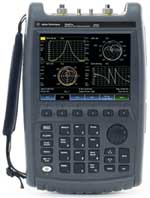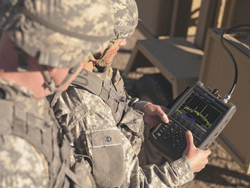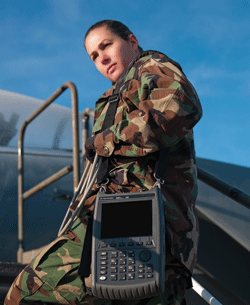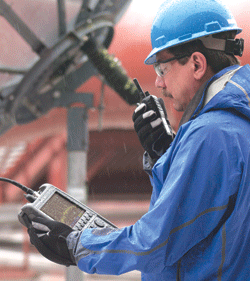
For most technical professionals, the phrase “precise microwave measurements” conjures up images of a comfortable indoor work environment. These days, more and more technicians and engineers need to make accurate microwave measurements in much harsher conditions: in a base transceiver station (BTS) during a snowstorm, aboard a ship in rough seas, at a satellite trailer in a sandstorm, and elsewhere (see Figure 1). In such scenarios, only the best gear — rugged, dependable and flexible — makes it into the “field kit.” Measuring up and earning a spot is the driving idea behind Agilent’s FieldFox handheld analyzers.
Meeting the Family
Inside and out, FieldFox handheld analyzers were designed with on-the-go applications — and end users — firmly in mind. Within its compact, 6.6 lb (3.0 kg) package, a FieldFox analyzer can be configured as a cable and antenna analyzer, spectrum analyzer and vector network analyzer (VNA). Additional capabilities include a power meter, vector voltmeter, an independent signal source, a variable DC supply, a frequency counter, an interference analyzer, and built-in GPS receiver. The FieldFox family now consists of sixteen models, with top-end frequencies of 4 and 6.5 GHz in the RF models and 9, 14, 18 and 26.5 GHz in the microwave models.

Figure 1 Agilent's FieldFox handheld analyzers provide precise microwave measurements in harsh conditions.

Figure 2 FieldFox helps reduce equipment costs by replacing a truck full of equipment with one compact instrument.
This level of flexibility can replace a variety of instruments (see Figure 2). It also enables a user to define a “just right” initial configuration and, later on, easily amend it with additional capabilities as needs change and budgets allow. Because those capabilities are inclusive, a CAT version can be enhanced with any of the other capabilities: spectrum analysis, network analysis, and so on.
Designing from the Ground Up
It is one thing to assemble a luggable analyzer that includes multiple functions. It is quite another to create a handheld instrument designed for the day-to-day workflows of technicians and engineers in the field. It is still another to provide handheld microwave measurements that agree with those made using a benchtop analyzer.
Rather than repurposing an existing benchtop instrument, the industrial and electronic design of FieldFox started with a clean sheet of paper. Defining and developing a suitable analyzer meant getting out of the design lab and tagging along with techs and engineers in the field. As they performed their daily work — from maintenance to troubleshooting — members of the FieldFox team were there, observing, asking questions and listening.
Creating a Field-Worthy Industrial Design
The team traveled to a variety of sites in vans, pickups and trucks. In most cases, the “good” instruments rode up front with the crew while the rest of the gear was tossed — literally — into the cargo area of a van or the bed of a pickup truck. In all cases, the people, vehicles, and instruments had to be equipped for a wide range of conditions — above ground or underground, day or night, rain or shine.
In FieldFox, these experiences translated into attributes that make it ready for the toughest conditions. To ensure durability in harsh environments, the completely sealed enclosure is compliant with US MIL-PRF-28800F Class 2 requirements. This spec covers the general requirements for test equipment used in the testing and calibrating of electrical and electronic equipment. Equipment designated as Class 2 is capable of operating in rugged operational environments that include unprotected, uncontrolled climatic conditions.
Putting It to the Test
During development, the FieldFox handheld analyzers underwent rigorous environmental testing. This included water, electrostatic discharge (ESD), vibration and shock. However, the toughest challenge was drop testing from three feet onto a concrete floor. During this process individual tests were performed on all six faces and every corner of the instrument.
Two key design attributes enable the instrument to survive these tests. One is the shape of the case. The shape was designed to disperse impact and increase the structural resistance to shock and impact from all angles. Additionally, the specially designed recessed RF connector bay protects this area from direct drops. The other attribute is the special polymer blend used in the case. In addition to its innate durability, the polymer is formulated to resist shattering at the low end of the specified operating temperature range.
Consistent with the specification, FieldFox has a water-resistant chassis, keypad and case that can withstand salty, humid environments and operating temperatures of –10° to +55°C (14° to 131°F). Gasket-sealed doors protect the instrument interfaces from moisture, and the dust-free design — with no vents or fans — helps extend instrument reliability. The case can also withstand shock and vibration. Finally, a specially designed connector bay protects the RF connectors from damage due to drops or other external impacts.

Figure 3 FieldFox handheld analyzers are designed for the day-to-day workflows of technicians and engineers in the field.
Defining Field-Ready Ergonomics
First-hand observations made indelible impressions that led to practical, meaningful decisions about ergonomics. For example, a nonslip rubber grip built into the case not only fits securely into the user’s hands, it also prevents the analyzer from sliding off the hood of a vehicle. The front-panel buttons are large enough to easily operate while wearing gloves (see Figure 3).
The vertical or “portrait” orientation and 7.4 inch (188 mm) width makes FieldFox easy to hold. Coupling that with a carefully designed keypad layout makes it easy for users to operate the instrument with their thumbs. Also, a weight of just 6.6 pounds (3.0 kg) makes FieldFox easier to carry than similar analyzers.
Because FieldFox may be used day or night, inside or outside, it includes a bright, low-reflective display and five display modes that optimize viewing under a wide range of lighting conditions. The keys are also backlit to enable operation in darkness.
Reducing Power Consumption
The electronic design of FieldFox is a natural extension of Agilent’s technological heritage. FieldFox integrates Agilent proprietary designs to deliver superior performance with smart power management technologies. For FieldFox, Agilent’s best measurement scientists enhanced those technologies to provide high performance with low power consumption. The result: FieldFox consumes less than 15 W and lasts 3.5 hours on a single charge. And because it consumes just 15 W of power, the enclosure can be completely sealed.
Leveraging Benchtop Capabilities
A FieldFox analyzer contains capabilities with the same measurement science and unique proprietary technology as Agilent’s benchtop analyzers, most of which are today’s highest performance microwave instruments. By providing levels of precision not available in any other handheld instrument, FieldFox ensures greater confidence in results.
In network analysis, built-in calibration engines leverage extremely accurate algorithms from high-end VNAs which enable precise and repeatable measurements. Agilent’s approach to calibration is leveraged from benchtop VNAs. With an emphasis on portability, Agilent simplified calibration by adding built-in calibration standards, so measurements can be made in the field without carrying additional accessories. With any other instrument, when additional devices to the test port are added, such as jumper cables, recalibration is required using an external calibration kit. CalReady is another unique feature that saves time in the field —turn it on and it is already calibrated to the end of the cable. This means it is immediately ready to make accurate measurements such as S11, S22 and VSWR.
To enhance spectrum analysis, the design team leveraged the power measurements used in Agilent spectrum and signal analyzers to the FieldFox spectrum analyzers. This enables users to make fast, accurate one-button power measurements of channelized communication systems easily and with confidence. FieldFox microwave spectrum analyzers save time by improving accuracy with InstAlign, an internal amplitude alignment that occurs automatically as the environmental conditions change, without any user intervention. This provides an industry-leading amplitude accuracy of ±0.5 dB at power-up, with no warm up required. FieldFox is the only 26.5 GHz handheld spectrum analyzer with a built-in full-band tracking generator.
Measuring up and earning a spot in the field kit is the driving idea behind the Agilent FieldFox handheld analyzers. With a unique combination of advanced measurement capabilities in an extremely rugged package, they are equipped to handle all field measurements — routine maintenance, in-depth troubleshooting, and more — everywhere technicians and engineers need to go.
Agilent Technologies,
Santa Clara, CA
(800) 829-4444,
www.agilent.com
